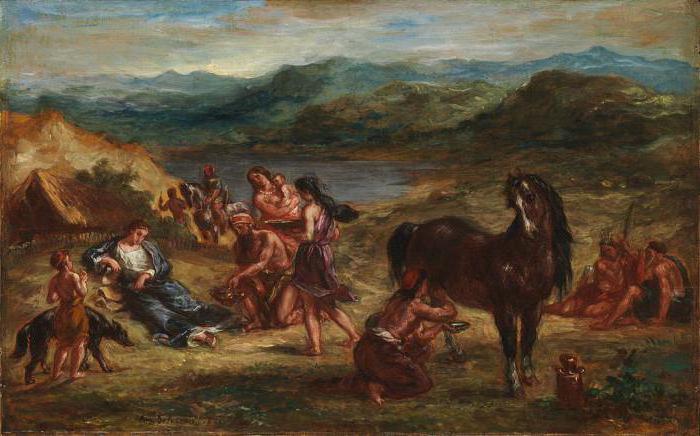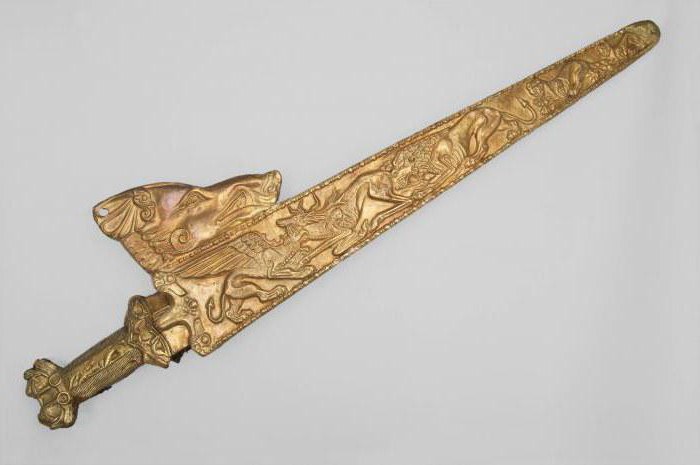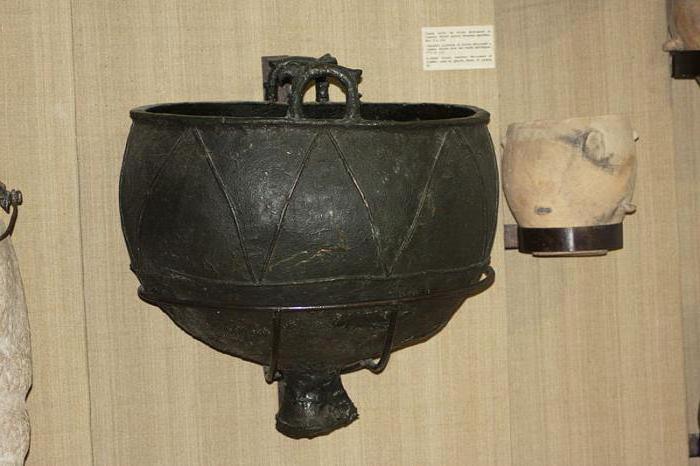The "Scythian world" took shape in the 1st millennium AD. It arose in the steppes of Eurasia. This is a cultural, historical and economic community, which has become one of the most outstanding phenomena of the ancient world.
Who are the Scythians?
The word "Scythians" is of ancient Greek origin. It is customary to use it to refer to all North Iranian nomads. We can talk about who the Scythians are in the narrow and broad sense of the word. In the narrow, only the inhabitants of the plains of the Black Sea region and the North Caucasus are called so, separating them from closely related tribes - Asian Saks, Dakhs, Issedon and Massagets, European Cimmerians and Sarmatians-Savromats. A complete list of all Scythian tribes known to the authors of antiquity consists of several dozen names. We will not list all these peoples. By the way, some researchers believe that the Scythians and Slavs have common roots. However, this opinion has not been proved, therefore it cannot be considered reliable.

We will also tell you about where the Scythians lived. They occupied a vast territory from Altai to the Danube. Scythian tribes eventually annexed the local population. Each of them has its own characteristics of spiritual and material culture. However, all parts of the vast Scythian world were united by a common origin and language, customs and economic activities. Interestingly, the Persians considered all these tribes to be one people. Scythians have a common Persian name - "Saki". It is used in a narrow sense to refer to the tribes inhabiting Central Asia. Unfortunately, we can only judge based on indirect sources about what the Scythians were like. Photos of them, of course, do not exist. Moreover, there is not much historical information about them.
The appearance of the Scythians
The image on the vase found in the Kul-Oba mound gave researchers the first real idea of how the Scythians lived, how they dressed, what their weapons and appearance were. These tribes wore long hair, a mustache and a beard. They dressed in linen or leather clothes: long trousers, harem pants and a caftan with a belt. They had leather boots on their feet, caught in ankle straps. The head of the Scythians was covered with felt pointed caps. As for weapons, they had a bow and arrow, a short sword, a quadrangular shield and spears.
In addition, images of these tribes are found on other objects found in Kul-Ob. For example, on a gold plaque there are two Scythians who drink from the rhyton. This is a rite of twinning, known to us according to the testimonies of ancient authors.
Iron Age and Scythian culture
The formation of the Scythian culture took place in the era of the spread of iron. Weapons and implements from this metal replaced bronze. After the method of manufacturing steel was discovered, the Iron Age finally triumphed. Tools made of steel made a real revolution in military affairs, craft and agriculture.
The Scythians, whose distribution area and influence were impressive, lived in the early Iron Age. These tribes owned the advanced technologies that were used at that time. They could mine iron from ore, then turn it into steel. The Scythians used different methods of welding, cementation, hardening, forging. It was through these tribes that the peoples of northern Eurasia became acquainted with iron. They borrowed metallurgy skills from Scythian artisans.
Iron in the Nart legends has magical powers. Kurdalagon is a heavenly blacksmith who patronizes heroes and heroes. The ideal of a man and a warrior is embodied by Nart Batraz. He is born iron, and then goes through hardening at a heavenly blacksmith. The Narts, defeating the enemy and capturing their cities, never touch the quarters of the blacksmiths. So the Ossetian epos of antiquity in the form of artistic images conveys the atmosphere characteristic of the early Iron Age.
Why did the nomads appear?
In the vast expanses, from the northern Black Sea region located in the west to the eastern Mongolia and Altai, more than 3 thousand years ago, a very original form of nomadic economy began to take shape. It covered a significant part of Central Asia and Southern Siberia. This type of economy was replaced by sedentary cattle-breeding and agricultural life. A number of reasons caused such important changes. Among them is climate change, as a result of which the steppe has dried up. In addition, the tribes mastered horse riding. The composition of the herds has changed. Now horses and sheep began to predominate in them, which could get their own fodder in the winter.
The era of the early nomads, as it is called, coincided with an important milestone in history, when humanity took a great historical step - iron became the main material used for the manufacture of both tools and weapons.
Noman life
The rational and ascetic life of the Nomans passed through harsh laws that required tribes to possess horse riding and excellent military skills. It was necessary to be ready at any time to protect their property or seize someone else's. The main measure of wealth for the Nomans was livestock. The ancestors of the Scythians received from him all the necessities: shelter, clothing and food.
Almost all the nomans of the steppes of Eurasia (with the exception of the eastern outskirts), according to many researchers, were Iranian-speaking in the early period of their development. For more than a millennium, domination in the steppe of Iranian-speaking nomads lasted: from the 8th-7th centuries. BC e. according to the first centuries AD e. The Scythian era became the heyday of these Iranian tribes.
Sources for judging Scythian tribes
At present, the political history of many of them, as well as their relatives (Tochars, Massagets, Daevs, Saks, Issedons, Savromats, etc.) is only fragmentarily known. Antique authors mainly describe the acts of large leaders and military campaigns of the Scythians. Other features of these tribes do not interest them. Herodotus wrote about who the Scythians are. Only this author, whom Cicero called the "father of history," can you find a fairly detailed description of the traditions, religion and way of life of these tribes. For a long time, very scarce information was available about the culture of the northern Iranian nomads. Only from the 2nd half of the 19th century, after excavations of the mounds belonging to the Scythians (in the North Caucasus and Ukraine) and the analysis of Siberian finds, did a whole scientific discipline called scyphology develop. Its founders are considered major Russian archaeologists and scientists: V.V. Grigoriev, I.E. Zabelin, B.N. Grakov, M.I. Rostovtsev. Thanks to their research, we received new information about who the Scythians are.
Genetic evidence
Despite the fact that the differences in the culture of the Scythian tribes were quite large, scientists identified 3 elements that indicate their genetic community. The first of them is horse decoration. The second element of the triad is the specific weapons that these tribes used (akinaki daggers and small bows). The third is that the art of all these nomads was dominated by the animal style of the Scythians.
Sarmatians (Sarmatians) who devastated Scythia
These peoples in the 3rd century BC. e. the next wave of nomads crowds out. New tribes devastated a significant part of Scythia. They destroyed the vanquished, and turned most of the country into a desert. This is evidenced by Diodorus of Sicily. Scythians and Sarmatians are tribes that came from the east. The nomenclature of sarmovatov is rather extensive. It is also known that there were several unions: roxolans, tongues, aorsa, syraki ... The culture of these nomads has many similarities with the Scythian. This can be explained by religious and linguistic kinship, that is, common roots. Sarmatian animal style develops Scythian traditions. Its ideological symbolism is preserved. However, the Scythians and Sarmatians are characterized by the presence of their own characteristics in art. For Sarmatians, it is not just a loan, but a new cultural phenomenon. This is an art that was born of a new era.
Alans development
The rise of the Alans, the new Northern Iranian nation, occurs in the 1st century AD. e. They spread from the Danube to the Aral Sea. The Alans participated in the Marcoman Wars that took place on the Middle Danube. They raided Armenia, Cappadocia and Madiah. These tribes controlled the Silk Road. Hun invasion in 375 e., put an end to their dominance in the steppe. A significant part of the Alans went to Europe with the Goths and Huns. These tribes left their mark in the many toponyms that are found in Portugal, Spain, Italy, Switzerland and France. It is believed that the Alans with their cult of military valor and sword, with their military organization and special attitude to women are at the origins of European chivalry.
These tribes throughout the Middle Ages were a notable phenomenon in history. The legacy of the steppe is visibly felt in their art. Settling in the mountains of the North Caucasus, part of the Alans retained their language. They became the ethnic basis in the education of modern Ossetians.
Separation of Scythians and Savromats
Scythians in a narrow sense, that is, European Scythians, and Savromats (Sarmatians), according to scientists, did not separate until the 7th century BC. e. Until that time, their common ancestors inhabited the steppes of the Ciscaucasia. Only after trips to countries beyond the Caucasus did the Sauromatians and Scythians disperse. From now on, they began to live in different territories. Cimmerians and Scythians began to quarrel. The confrontation between these peoples ended in the fact that the Scythians, having retained the bulk of the North Caucasian plain, captured the Northern Black Sea coast. The Cimmerians who lived there, they partially supplanted, and partially subjugated to themselves.
Savromats now inhabited the steppes of the Urals, Volga and Caspian. The Tanais River (the modern name is Don) was the border between their possessions and Scythia. In ancient times, the legend about the origin of the Sauromats from the marriage of Scythians with the Amazons was popular. This legend explained why the Sauromat women held a high position in society. They rode on a par with men and even participated in wars.
Issedon
Issedons were also distinguished by gender equality. These tribes lived east of the Savromats. They inhabited the territory of present-day Kazakhstan. These tribes were famous for their justice. They were attributed to nations that did not know resentment and enmity.
Dahi, Massageti and Saki
Dahi inhabited the Caspian Sea, on its eastern coast. And east of them, in the semi-deserts and steppes of Central Asia, were the lands of the Massagets and Saks. Cyrus II, founder of the Achaemenid Empire, in 530 AD e. made a trip to the massagets who inhabited the region near the Aral Sea. These tribes were ruled by Queen Tomiris. She did not want to become the wife of Cyrus, and he decided to take possession of her kingdom by force. The Persian army was defeated in the war against the massagets, and Cyrus himself died.
As for the Saks of Central Asia, these tribes were divided into 2 associations: Saki-haumavarga and Saki-tigrahauda. So they were called the Persians. The tiger in translation from ancient Persian means "sharp", and hauda - "helmet" or "hat". That is, saki-tigrahauda - saki in pointed helmets (hats), and saki-haumavarga - worshiping haoma (sacred drink of the Aryans). Darius I, the Persian king, in 519 BC e. made a campaign against the tribes of tigrahaud, having conquered them. The skunha, captured by the leader of the Saks, is depicted on a relief carved by order of Darius on the Behistun rock.
Scythian culture
It should be noted that the Scythian tribes created a rather high culture for their time. It was they who determined the path of further historical development of many regions. These tribes participated in the education of many peoples.
Scythian annals were kept in the empire of Genghis Khan, rich literature with legends and legends was presented. There is reason to hope that most of these treasures have survived to this day in underground vaults. The culture of the Scythians, unfortunately, remains poorly understood. In ancient Indian legends and Vedas, in Chinese and Persian sources it is said about the lands of the Siberian-Urals region, on which unusual people lived. At the Putorano plateau, as they believed, the cloisters of the gods were located. These places attracted the attention of the rulers of India, China, Greece, Persia. However, interest usually ended with economic, military or other aggression against great tribes.

It is known that at different times the troops of Persia (Darius and Cyrus II), India (Arjuna and others), Greece (Alexander the Great), Byzantium, the Roman Empire, etc. invaded Scythia. We know from historical sources that that Greece showed interest in these tribes: the doctor Hippocrates, the geographer Hekatius of Miletus, the tragedians Sophocles and Aeschalus, the poets Pandor and Alkaman, the thinker Aristotle, the logographer Damast, etc.
Two legends about the origin of Scythia, narrated by Herodotus
Herodotus told two legends about the origin of Scythia. According to one of them, Hercules, being here, met an unusual woman in the Black Sea (in the cave of the land of Gilea). Its lower part was serpentine. Three sons were born from their marriage - Agafirs, Scythian and Gelon. Scythians came from one of them.
We briefly outline another legend. According to her, the first person to appear on earth was Targitai. His parents were Zeus and Borisfen (daughter of the river). They had three sons: Arpoksai, Lipoksai and Kolaksai. The eldest of them (Lipoksai) became the ancestor of the Scythians-Avkhats. Traspia and catarias descended from Arpoksay. And from Kolaksai, the youngest son, - royal paralyzes. These tribes are collectively called cleaved, and the Greeks began to call them Scythians.
Kolaksai first divided the entire territory of Scythia into 3 kingdoms, which went to his sons. One of them, where gold was stored, he made the largest. The area north of these lands is covered in snow. About I millennium BC. e. Scythian kingdoms arose. It was the time of Prometheus.
The connection of the Scythians with Atlantis
Of course, one cannot consider the history of the peoples of Scythia the legend about the family tree of the kings. The history of these tribes is believed to have roots in Atlantis, an ancient civilization. This empire included, besides an island in the Atlantic Ocean, where the capital was located (Plato described it in the dialogs "Critias" and "Timaeus"), lands in northwestern Africa, as well as Greenland, America, Scandinavia and northern Russia. All regions located around the North geographic pole belonged to it. The island lands located here were called the Middle Earth. They were inhabited by the distant ancestors of the Asian and European peoples. On the map of G. Mercator, dating back to 1565, these islands are represented.
Scythian economy
Scythians - a people whose military power could develop only on a strong socio-economic basis. And they had such a base. In Scythian lands more than 2.5 thousand years ago there was a warmer climate than in our time. The tribes developed livestock farming, farming, fishing, and produced leather and textile goods, fabrics, ceramics, metals and wood. Manufactured military equipment. The quality and level of Scythian products was not inferior to Greek.

The tribes provided themselves with everything that was necessary. They were engaged in the extraction of gold, iron, copper, silver and other minerals. In Scythians, casting production reached a very high level. According to Herodotus, who composed the description of the Scythians, in the 7th century BC. e., under King Ariant, these tribes cast a huge copper pot. The thickness of its wall was 6 fingers, and the capacity was 600 amphoras. It was cast on the Desna River, south of Novgorod-Seversky. During the invasion of Darius, this cauldron was hidden east of the Desna. It also mined copper ore. Scythian gold relics are hidden in Romania. This is a bowl and a plow with a yoke, as well as a double-edged ax.
Trade of Scythian tribes
Trade was developed on the territory of Scythia. There were water and land trade routes along the European and Siberian rivers, the Black, Caspian and North Seas. In addition to war chariots and wheeled carts, the Scythians built river and sea flax-winged ships in the shipyards of the Volga, Ob, Yenisei, at the mouth of Pechora. Genghis Khan took craftsmen from these places to create a fleet designed to conquer Japan. Sometimes the Scythians built underground passages. They laid them under large rivers, using mining technology. By the way, tunnels under rivers were also laid in Egypt and in other states. The press has repeatedly reported underground passages under the Dnieper.
The busy trade routes from India, Persia, and China ran through Scythian lands. Goods were delivered to the northern regions and Europe along the Volga, Ob, Yenisei, the North Seas, and the Dnieper. These paths operated until the 17th century. In those days, there were cities on the banks with noisy bazaars and temples.
Finally
Each nation goes its own historical path. As for the Scythians, their path was not short. Over a thousand years history has measured them. For a long time, the Scythians were the main political force on a large territory located between the Danube and the Don. The study of these tribes involved many prominent historians and archaeologists. Research does not stop to this day. They are joined by specialists from related fields (for example, climatologists and paleogeographers). It can be expected that the collaboration of these scientists will provide new information about what the Scythians were like. The photos and information that was presented in this article, we hope, helped you to get a general idea about them.